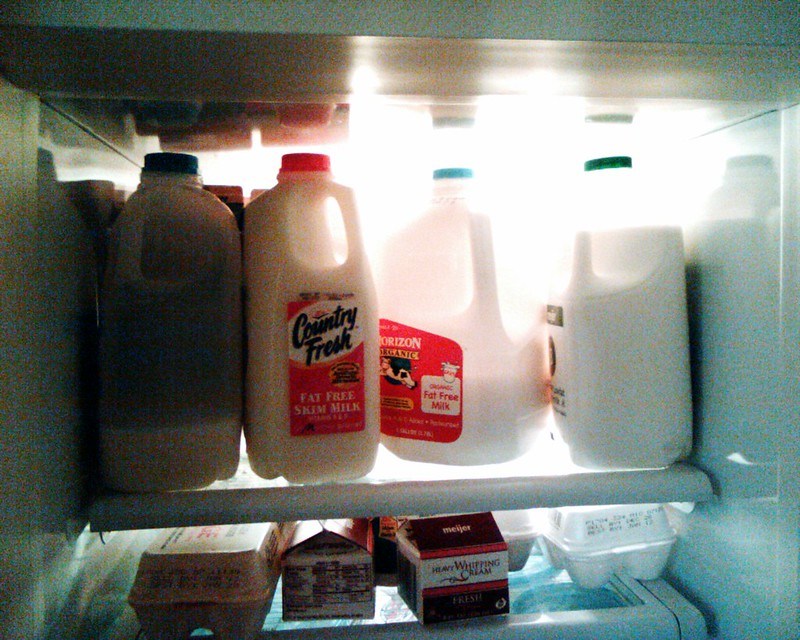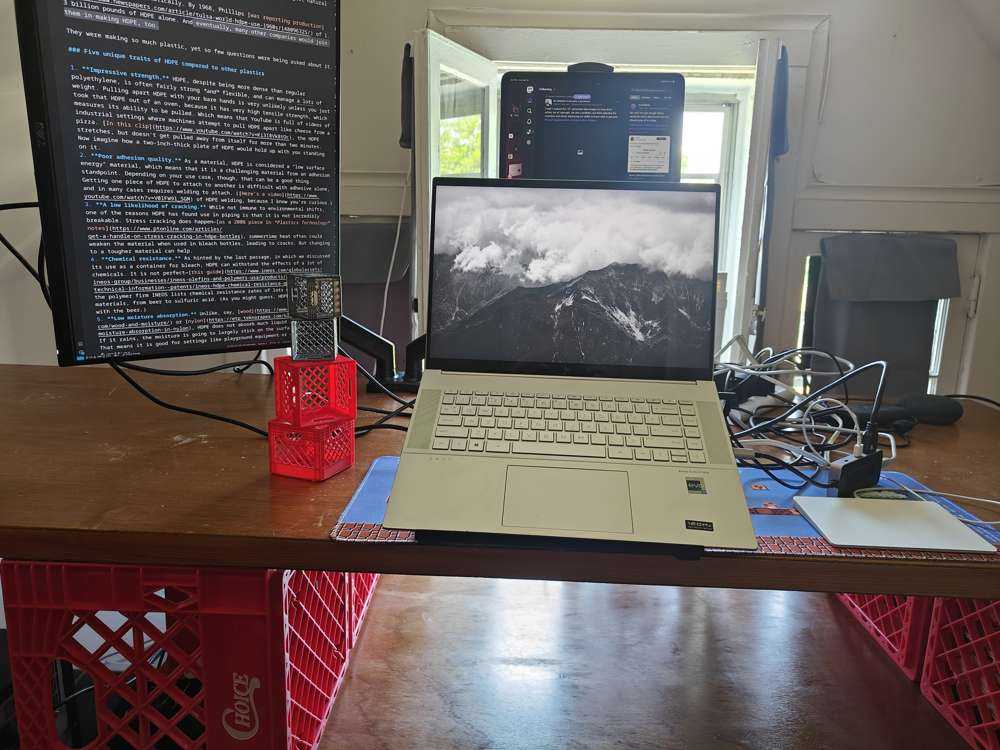Today in Tedium: Recently I heard about a form of wood as strong as steel, an idea that sounds wild when written out. How? Wood is a material I associate with broken guitars and broken chairs. But apparently there is something special about MettleWood, where they soften the cell wells of a piece of wood, then compress it flat. It’s a repeatable process, and one that reportedly improves its resistance to things normal pieces of wood have to worry about—like fire, moisture, and termites. With manufacturing expected to pick up soon, it could lead to more wood-covered buildings—or, fascinatingly, buildings where steel foundations have been replaced with highly compressed blocks of wood. About 70 years ago, plastics went through a similar revolution, where a new process emerged, changing the public’s relationship with it. Today’s Tedium discusses how high-density polyethylene (HDPE) came to shape our relationship with plastics. — Ernie @ Tedium
Is your iPhone packed to the gills with old photos? The new CleanMyPhone might be your solution. This tool, by the makers of CleanMyMac, helps make it easy to separate an outtake from a keeper—and save a bunch of space in the process. Click here for a free trial, iPhone fans.
twice
The number of times chemists accidentally discovered polyethylene—first in the 1890s by chemist Hans von Pechmann (who was heating diazomethane, and didn’t follow up on what he built), and then in the 1930s by Imperial Chemical Industries (which uncovered it accidentally, caused a fire when trying to recreate the process, then tried again successfully a couple years later). The plastic, used for basically everything, is perhaps the most common plastic around, but it didn’t have its moment in the sun until the 1950s, after another pair of discoverers uncovered a process to make it stronger.

We’re milking these plastics for all they’re worth. (Chris Chan/Flickr)
HDPE: Why I find this specific polymer interesting enough to write about
You may be wondering: Ernie, newly minted pseudo-search-engine owner, there are so many kinds of plastic out there. Why write a piece specifically about HDPE? Why not just “plastic”?
Well, here’s the thing. Recently, I had an idea. The idea started from a modest fascination with a common object, the milk crate. I remember as a young kid being deeply fascinated with them, particularly how solid they were.
If you follow my writing closely, you may know that I find milk crates fascinating enough that I own the domain DairyCrates.com, a website dedicated to milk crates. Not a lot is there. It’s kind of a placeholder, but IMHO, it has a pretty cool lead image.
Part of the interest and value in the milk crate is its use of high-density polyethylene (HDPE), a thick plastic stronger than many similar materials. HDPE is pretty common, but it gives the thicker-than-usual milk crate its superpowers. According to Farmplast, a major manufacturer of milk crates, the combination of the materials and the structure means the crates can withstand 2,500 pounds of sustained pressure from a hydraulic press. That’s pretty good!
(You may want to skip the Milk Crate Challenge, though.)

OK, this isn’t Pinterest ready. I just want to ensure that it’s clear I’m actually doing this, and not just making some stuff up.
My idea was essentially this: Let’s make a desk out of milk crates. I found a couple of old doors as surfaces, and a source for milk crates on the cheap (easier said than done, due to the objects’ sheer size), and was able to pull it off within a limited budget, spending less than $200 all in. The desk sits next to a window, uses six milk crates, a couple supports, and a strategically placed old book. It maximizes space in a room and gives me a window view, something I haven’t really had in a long while. And it’s pretty darn stable, thanks in large part to the milk crates.
And it wouldn’t have been possible without the help of a pair of chemists at the Phillips Petroleum Company.
Robert L. Banks and J. Paul Hogan, over a couple of years, developed two of the most important building blocks of the plastics era, putting Phillips in a strong position to enter a new market for itself. The first, polypropylene, was uncovered by accident in 1951 during a process to find components for gasoline, and ended up finding a material used in food containers and plastic bags the world over.
(Interestingly, there was a debate over who first made polypropylene, with a pair of European inventors initially credited for the discovery. Maybe we can cover that in a follow-up.)
Realizing that there might be potential to further this research, Banks and Hogan convinced their bosses at Phillips to transition into building plastics. It was during this process, as documented by the American Chemical Society, that they uncovered HDPE, improving the density of polyethylene, considered a low-density polymer, by limiting the amount of molecular “branching” in the material, which had the effect of strengthening the material significantly.
Essentially, what Banks and Hogan built is not all that dissimilar to the new wood variant mentioned above, in that HDPE was denser than regular polyethylene, improving its tensile strength. It was less likely to crack and could better withstand heat.
Phillips commercialized Banks and Hogan’s work 70 years ago this year, and it gradually proved immensely popular. The company put a $50 million marketing budget to good use. As a 1955 full-page ad for the product in the Des Moines Register, which they named Marlex, puts it:
Although Marlex is a greatly improved type of polyethylene, its method of manufacture is truly revolutionary. Instead of using high temperatures and pressures in the polymerization reaction, Marlex is made by a continuous process using a catalyst and operating at low pressure and temperature. This not only results in economies and better control of quality and uniformity, but also permits the production of a whole series of new plastics tailored for the needs of specific applications.
Clearly, Phillips thought that what they developed would quickly find sustained use throughout society. But there was just one problem—the market did not immediately materialize at the scale they expected. It was an excellent material—without any obvious use cases.
But eventually, the product Gods did shine upon Marlex, and the turning point came thanks to a well-known fad that reflected a rising interest in toys. The first hit HDPE product, interestingly enough, was the Hula Hoop, developed in the mid-1950s by an Australian manufacturer named Toltoys, which switched to plastic hoops after it ran out of bamboo.
After success in its local market, the wacky toy-makers at Wham-O got wind of the device (apparently screwing over a husband and wife who uncovered the device’s success in Australia), working with Phillips to use Marlex as its production material. And from there, the Hula Hoop’s—and HDPE’s—success exploded, with millions of pounds of HDPE finding its way into consumers’ hands thanks to the simple toy.
T.L. Cubbage, a Phillips Chemical vice president, was quoted in 1959 stating that the toy “did more to build a world market for this new polyethylene in a relative short time than any other application.”
Of course, a fad is not a market. It took a little time for HDPE to find its footing, with use cases like bottles, piping, and (yes, more) toys continuing to emerge. In 1962, Phillips reported to the Tulsa World-Herald that it was making 100 million pounds of plastics per year—strengthening its already existing reputation of being the largest natural gas producer of the period.
That would increase dramatically. By 1968, Phillips was reporting production of 1.3 billion pounds of HDPE alone. And eventually, many other companies would join them in making HDPE.
They were making so much plastic, yet so few questions were being asked about it.
Five unique traits of HDPE compared to other plastics
- Impressive strength. HDPE, despite being denser than regular polyethylene, is often fairly strong and flexible, and can manage lots of weight. Pulling apart HDPE with your bare hands is unlikely, unless you just took HDPE out of an oven, because it has high tensile strength, which measures its ability to be pulled or stretched. Which means YouTube is full of videos of industrial settings where machines attempt to pull HDPE apart like cheese from a pizza. In this clip, the HDPE stretches, but doesn’t get pulled away from itself for more than two minutes. Now imagine how a two-inch-thick plate of HDPE would hold up with you standing on it.
- Poor adhesion quality. As a material, HDPE is considered a “low surface energy” material, a challenging material from an adhesion standpoint. Depending on your use case, though, that can be a good thing. Getting one piece of HDPE to attach to another is difficult with adhesive alone, and in many cases requires welding to attach. (Here’s a video of HDPE welding, because I know you’re curious.)
- A low likelihood of cracking. While not immune to environmental shifts, one of the reasons HDPE has found use in piping is that it is not incredibly breakable. Stress cracking does happen—as a 2008 piece in Plastics Technology notes, summertime heat often could weaken the material when used in bleach bottles, leading to cracks. But changing to a tougher material can help.
- Chemical resistance. As hinted by the last passage, in which we discussed its use as a container for bleach, HDPE can withstand the effects of numerous chemicals. It is not perfect—this guide from the polymer firm INEOS lists chemical resistance rates of lots of different materials, from beer to sulfuric acid. (As you might guess, HDPE has better luck with the beer.)
- Low moisture absorption. Unlike, say, wood or nylon, HDPE does not absorb much liquid spilled on it. If it rains, the moisture largely stays on the surface and dries off. That means it is good for settings like playground equipment or outdoor furniture.
UHMWPE
The acronym for ultra-high-molecular-weight polyethylene, a plastic similar to HDPE but built around tightly packed polymer chains, which makes the material perhaps less malleable than HDPE, but far stronger, even more heat resistant, and less susceptible to corrosion. That makes it perfect for hip replacements, with the first occurring in 1962, and as body armor. (Yes, there’s video of people shooting bullets into the material).

This symbol feels like a lie when it comes to plastic. Can HDPE be the exception? (Rivage/Unsplash)
Can the massive glut of HDPE sitting around everywhere secretly be a good thing?
Mold first, ask questions later. That was the apparent M.O. of the plastics industry for so many years, and we’re arguably all the worse for it.
We now know that plastics are difficult to recycle. In recent years, after many decades of hearing that we should recycle plastics, the truth has come out that we often do not do so, in part because plastics degrade in quality or have different physical qualities upon recycling. As a 2022 NPR piece put it:
Waste management experts say the problem with plastic is that it is expensive to collect and sort. There are now thousands of different types of plastic, and none of them can be melted down together. Plastic also degrades after one or two uses. Greenpeace found the more plastic is reused, the more toxic it becomes.
New plastic, on the other hand, is cheap and easy to produce. The result is that plastic trash has few markets—a reality the public has not wanted to hear.
That’s the bad news. But what about HDPE? But HDPE is different from many plastics—it largely does not lose its qualities as it’s recycled. HDPE still looks like HDPE after you rejigger it into something else.
Recycling HDPE is relatively easy—and if you were so motivated, you could technically do it at home. One example I found in my research: About a decade ago, a YouTuber named Peter Brown created his own brick of recycled HDPE by using a blender to shrink the size of the plastic, then melting it using a toaster oven (which he had to switch to after a griddle didn’t work).
A user on Instructables describes their plastic-melting experience, using canola oil and a large pan, as such:
The process is quite simple. Cut up the bottles, stew them in really hot canola oil on the stove in a pot, and then take the hot plastic and press it into a form to cool. Please note that melting some plastics can release toxic fumes. I have had no issues with HDPE, however I am not a chemist and cannot comment on the health risks of this process.
The pieces of cut up bottle can be any size that [fits] in the pot. I washed the bottles and removed the labels before cutting. Pouring a small amount of near boiling water into the bottle and swishing it around will help release the glue on the labels. Otherwise, the labels tend to tear.
Most any cooking oil will work, and you don't need too much. I just put a couple of inches in the bottom of the pot. Canola oil is inexpensive and has a smoke point of over 400 F (204 C). The melting point of HDPE is in the mid 200 F range, but the "extrusion" temperature range is 350 - 500 F. I used oil heated on my stove top to a little over 350. Just make sure that the bottle pieces are dry, or the water will cause oil to pop out of the pot. I used a candy thermometer to keep track of the temperature.
If you’ve ever seen a product with recycled plastic, it often has specks of random colors. You can credit the fact that recyclers have to use similar processes of breaking plastics down to the chip level.
Plastics of this nature are so prevalent, in fact, that this could be a good solution for dedicated DIYers who want to build a table out of old plastic.
But different plastics are less suited to certain tasks. Sadly, HDPE struggles in one of the most prominent use cases for plastic at the DIY level, 3D printing. As a filament, HDPE is unpopular because of the material’s tendency to shrink or warp. The place for HDPE is in less-tailored, more molded recycling settings.

An example of “plastic lumber” in the wild … mixed with some wood. (Wikimedia Commons)
However, recycled HDPE could have some important use cases as a recycled building material. In 2016, Rutgers material science professor Thomas Nosker gained notoriety for developing a form of plastic lumber from HDPE, which he helped create specifically to create a viable market for recycled HDPE, which can hold up to the elements slightly better, than say, wood. Perhaps, wandering around a local park one day, you’ve seen a picnic table built from recycled plastic in the past few years. You can credit Nosker for helping to foster that concept.
“People complain about plastics because they don’t degrade,” Nosker said in 2016. “We found a way to turn that to our advantage with a product.”
(He draws the line at plastic roads, however, which have been bandied about as an idea for recycling plastic and defeating potholes, but he says will fail to stand up to changes in environments with severe temperature shifts throughout the year. As he told the New Jersey Monitor in 2022: “Basically, when the wintertime came, the roads would suddenly develop big cracks.”)
It can even be used to give a splash of color or visual flair to a design. Recently, The Good Plastic Company, a European firm, entered the U.S. market with its product PolyGood, a material that leans into the recycled nature of its HDPE to offer interesting visual designs that would look amazing as a backdrop, or perhaps, on the surface of a sub-$200 milk crate desk. Some materials are translucent; some are very white, or very black. All look extremely cool.
But the problem is, we use so much plastic, HDPE included, that it can feel like a drop in the bucket, when the original material is so much cheaper to produce than its recycled equivalent. It feels like a situation where someone needs to step in and change manufacturer motivations, which honestly favor the status quo until you start showing sizzle reels of ocean waste.
Look, it is no surprise to anyone reading this that plastic has an environmental problem at its root. People consume plastic, but that plastic doesn’t re-enter the stream, and it isn’t recycled to the degree it could be.
(And of course, as the title hints, there is also the problem of microplastics, expanding an environmental problem into something that’s also potentially a health problem.)
I, too, like melting plastic in a panini maker.
But there is still something to admire about the ingenuity that originally gave us certain plastics, HDPE included.
Like what we’re seeing with modern computing devices, HDPE is a quite fascinating and useful material that has suffered from being attached to a mechanism of capitalism that encourages aggressive overuse. That’s the bad news.
The good news is that HDPE is much more recyclable than many other types of plastic, and that means it could potentially live diverse secondary lives if we’re willing to put in the work as a society.
Are we willing to put in the work? (And will my milk crate desk do its part?)
--
Find this one an interesting read? Share it with a pal!
And if you need to clean out your old pics, give CleanMyPhone a spin.






